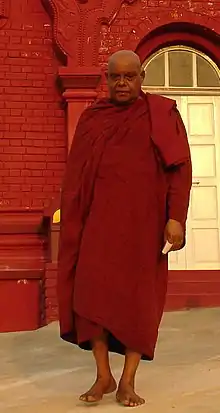Sri Lankan Forest Tradition
Sri Lankan Forest Monks' Tradition claims a long history. As the oldest Theravada Buddhist country in the world, several forest traditions and lineages had been existed, disappeared and re-emerged circularly in Sri Lanka. The current forest traditions and lineages in Sri Lanka have been influenced by the Thai and Burmese traditions which descend from the ancient jambudeepa (Indian) and Seehaladeepa (Sri Lankan) traditions.[1][2][3]
| Part of a series on |
| Theravāda Buddhism |
|---|
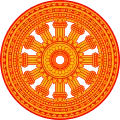 |
Historical background
Establishment of Buddhism in Sri Lanka

After the era of great Indian Emperor Asoka, India lost her place as the Theravada Buddhist center of the world. It is said that emperor Asoka and his advisor monks predicted this would happen and organized a Theravada Buddhist Mission to nine countries in Asia. As a result of this mission, the great arahant Mahinda who was the son of emperor Asoka was sent to Sri Lanka in order to establish Buddha Sasana (message of the Lord Buddha) with a group consists with six arahants called Ittiya, Uttiya, Sambala, Bhaddasala, Novice Sumana (Sumana Samanera) and anagami layman Bhanduka (Bhanduka Upasaka).[4][5]
The King Devanampiya Tissa who was the king of Sri Lanka at that period met this group and accepted Buddhism and declare Buddhism as the state religion of Sri Lanka. The vice king Arittha who was the cousin of king Devanampiya Tissa was the first Buddhist monk of Sri Lanka who was called as arahant Upatissa.[6]

One year Later the emperor Asoka decided to send another group to Sri Lanka in order to establish Buddhist Nuns' order (Bhikkhuni order) in Sri Lanka. The leader of this group was the daughter of the emperor Asoka who was the great arahant nun Sanghmitta. In addition to that eighteen groups of technical people which were dedicated for Buddhist cultural works were sent with arahant Sanghamitta in order to strengthen the established Buddhist Lineage in Sri Lanka.[7]
Theravada Buddhism

Since the first days of the establishment of a Theravada Buddhist Lineage in Sri Lanka, it has remained the main tradition there. After the era of the great Indian emperor Asoka, Sri Lanka was the epicenter of Theravada tradition in the world. The Pali Canon (Theravada Tipitaka), which was preserved and conveyed by memorization and recitation, was first written in Sri Lanka at the Aluvihara in Matale. Almost all the early commentaries of Dhamma (Attha Katha) were written in Sri Lanka. The popular commentary writer Bhiikku Buddhaghosa was able to translate Sri Lankan commentaries which had been written in Sinhala Language, into the Pali Language during the Anuradhapura era.[8]
When other Theravada countries such as Siam (Thailand) and Ramanna (Part of Burma/Myanmar) lost their monastic lineage, Sri Lankan monks were sent to re-establish the Upasampada monks' lineage during the period of Polonnaru Kingdom in Sri Lanka. Later, in the 17th century CE, the Upasampada Lineage had disappeared in Sri Lanka due to attacks and the subsequent domination of Western intruders. A novice monk, Weliwita Saranamkara, brought Upasampada from Siam (Thailand) and was able to reestablish the lineage in Sri Lanka. During the 18th century several monks were able to again bring new Upasampada lineages from Amarapura (a part of Burma/Myanmar) and Ramanna (a part of Burma/Myanmar).[9]
Today three main Theravada Nikayas (Lineages) such as Siam Niakaya, Amarapura Nikaya, Ramanna Nikaya are dominant in Sri Lanka; Siyam Nikaya is the lineage from Siam, Amarapura Nikaya is the lineage from Amarapura and the Ramanna Nikaya is the lineage from Ramanna.[10]
Ascetic forest traditions
Early days the forest traditions were affiliated with the ancient monasteries such as Mihintale monastery, Ritigala monastery and Dimbulagala Monastery, among others. Many ruins of ancient forest monasteries can be seen in the large forest areas of Anuradhapura, Polonnaruwa, Matale, Tissamaharama, Situlpawwa and Ruhuna. In that days Sri Lanka was the center of both Theravada village and forest traditions in the world. Currently the largest forest sect in Sri Lanka is the Sri Kalyani Yogashrama Samstha (Galduva Sect) of Ramanna Nikaya. In addition to that Vaturuvila Vanavasa sect of Siam Nikaya and several monasteries of all the three Nikayas continue to have forest monasteries.[11][12]
Contemporary monks
Matara Nanarama Maha Thera
Matara Nanarama Maha Thera who is considered to be the father of the Sri Lankan modern forest meditation tradition had developed a new meditation system which is balanced in both Vipassana and Samatha by researching through old Sri Lankan meditation methods and by learning Burmese Mahasi Vipassana Method. Some of his best student monks are listed below.[13]
- Mitirigala Dhammavasa Maha Thera[14]
- Katukurunde Nyanananda Maha Thera
- Udairiyagama Dhammajiva Maha Thera[15]
- American Bhikkhu Kovida [16]
- Nauyane Ariyadhamma Maha Thera
- Greek Nyanadassana Maha Thera
Nauyane Ariyadhamma Maha Thera
A student of late venerable Kadavedduve Jinavamsa Maha Thera who was the founder of the Sri Kalyani Yogashrama Samstha as well as Sayadaw U Āciṇṇa who was the founder of Pa-Auk Tawya Monastery. He had an exceptional Mindfulness (Sati-memory and awareness) and control in the physical actions (Kaya Samvara) and day-to-day activities. It is said that he was a Bhodhisatva who was hoping to reach the Buddhahood in a future life.
Katukurunde Nyananada Maha Thera
A famous book author who published "The Magic of the Mind" and many other books.[17] When he was residing in Mitirigala Nisssarana Vanaya, his teacher, the most venerable Matara Nanarama Maha Thera was the person to invite him to conduct the set of sermons on controversial topic 'Nibbana - The Mind Stilled'.[18]
Udairiyagama Dhammajiva Maha Thera
A well-known Vipassana meditation master who put emphasis on the value of Mindfulness (Sati) in meditation practice. He was influenced by Sri Lankan meditation method through Matara Nyanarama Maha Thera as well as by Burmese Mahasi method through Sayadaw U Pandita. He was a student of both of these great meditation masters.[19]
Other notable monks
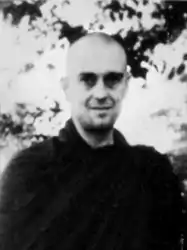
- Kadawedduwe Jinavamsa Maha Thera
- German Nanavimala Maha Thera [20]
- Danish Nanadipa Maha Thera
- British Nanavira Thera [21]
- Vaturuvila Gnanananda MahaThera
Contemporary forest monasteries
There are many forest monasteries scattered throughout Sri Lanka. Some of the main monasteries are listed below.[22]
Mitirigala Nissarana Vanaya
_Dodanduwa_Island%252C_Galle_District%252C_Sri_Lanka.jpg.webp)
Mitirigala Nissarana Vanaya is Located in the Western Province close to Colombo. First Abbot was late venerable Matara Nanarama Maha Thera. Affiliated to Kalyani Yogashrama Samstha. A branch monastery is established in Ritigala in North Central Province. Meditation method practiced here is related to both Sri Lankan tradition of most venerable Matara Nanarama Maha Thera and Burmese Mahasi Vipassana Method. Current abbot is the popular meditation master venerable Udairiyagama Dhammajiva Thera.[23]
Na Uyana Aranya
.JPG.webp)
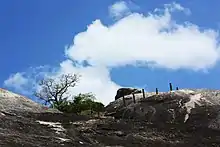
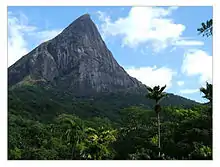
Na Uyana Aranya is situated in the North Western Province. This is a monastery currently following the Pa Auk method of meditation and related with the Pa-Auk Forest Monastery in Myanmar. The late most venerable Nauyane Ariyadhamma Maha Thera was an abbot of Na Uyana Aranya.[24]
Solitary dwelling
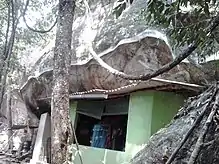
Laggala forest
A group of three wall kutis in the Laggala forest close to knuckles mountains in the north Central province. Independent solitary meditation practice is done by monks with daily alms round and fortnightly Patimokkha chanting. The famous ascetic monk Danish Nanadipa lived in the cottages of the Laggala forest for several decades. American Bhikkhu Kovida was another famous character in 1980s at Laggala.[25]
Thanjanthenna forest
A group of kutis (caves and huts) situated at Balangoda forest areas in which both local and foreign monks reside in.[26]
Caves and kutis in the forests
There are plenty of single cottages and cave scattered all over the country which used by monks to dwell in. Some of them include Bundala Kut, Moragaha Ulpatha Kuti, Sangharaja Gallena.[27]
References
- Mahānāma (1993). The Mahāvaṃsa, Or, The Great Chronicle of Ceylon. Asian Educational Services. ISBN 9788120602182.
- Parker, Henry (1981). Ancient Ceylon. Asian Educational Services. ISBN 9788120602083.
- Prasopchingchana, Sarunya. "Buddhist Relationship between Sri Lanka and Thailand" (PDF). Cite journal requires
|journal=(help) - "LankaWeb – Establishment of Buddha Sasana in Lanka by Arahat Mahinda". Retrieved 2018-08-27.
- "LankaLibrary.com: The arrival of Buddhism in Sri Lanka". www.lankalibrary.com. Retrieved 2018-08-27.
- "King Devanampiya Tissa". mahavamsa.org. Retrieved 2018-08-27.
- Mahānāma (1993). The Mahāvaṃsa, Or, The Great Chronicle of Ceylon. Asian Educational Services. ISBN 9788120602182.
- "The Tripitaka committed to writing at Aluvihara". archives.sundayobserver.lk. Retrieved 2018-08-27.
- "On the trail of a Thera and his Upasampada mission here | The Sunday Times Sri Lanka". www.sundaytimes.lk. Retrieved 2018-08-27.
- Williams, Paul (2005). Buddhism: The early Buddhist schools and doctrinal history ; Theravāda doctrine. Taylor & Francis. ISBN 9780415332286.
- Knighton, W. (William) (1854). Forest life in Ceylon. University of California Libraries. London : Hurst and Blackett.
- Freiberger, Oliver (2006-10-19). Asceticism and Its Critics: Historical Accounts and Comparative Perspectives. Oxford University Press. ISBN 9780199719013.
- "The Island-Features". www.island.lk. Retrieved 2018-08-27.
- "Most Venerable Mitirigala Dhammavasa Maha Thero | Mithrigala Nissarana Vanaya". www.nissarana.lk. Retrieved 2018-01-17.
- "Most Venerable UdaEriyagama Dhammajiva Maha Thero | Mithrigala Nissarana Vanaya". www.nissarana.lk. Retrieved 2018-01-17.
- "A Majestic Tree of Merit Biography of The American Bhikkhu Kovida » Dhammikaweb". www.dhammikaweb.com. Retrieved 2018-01-17.
- "Books | seeing through the net". seeingthroughthenet.net. Retrieved 2018-01-17.
- "Bhikkhu Ñanananda". www.accesstoinsight.org. Retrieved 2018-08-27.
- Soo, Lee Chin. "Singapore DharmaNet Homepage". www.buddha.sg. Retrieved 2018-08-27.
- "Ven Nyanavimala - Pure Inspiration". /ven-nyanavimala.buddhasasana.net. Retrieved 2018-01-17.
- User, Super. "About - Ñāṇavīra Thera Dhamma Page". www.nanavira.org. Retrieved 2018-01-17.
- "Buddhist Forest Monasteries and Meditation Centres in Sri Lanka" (PDF).
- "Meetirigala Nissarana Vanaya". www.nissarana.lk. Retrieved 2018-08-27.
- Aranya, Na Uyana. "Na Uyana Aranya". www.nauyana.org. Retrieved 2018-08-27.
- Wickremeratne, Swarna (February 2012). Buddha in Sri Lanka: Remembered Yesterdays. SUNY Press. ISBN 9780791481141.
- "Bhaddeka Vihari". www.bhaddekavihari.org. Retrieved 2018-01-17.
- "Bundala Kuti - The Legend of Bundala".
